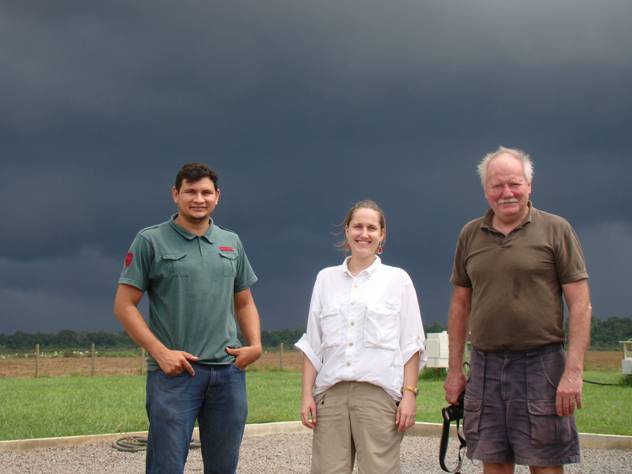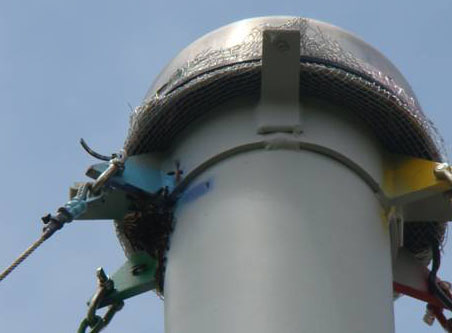On the Amazon: Setup
Published: 27 January 2014
Editor’s note: Stephen R. Springston, a scientist at Brookhaven National Laboratory and an instrument mentor for ARM’s Aerosol Observing System, sent this update.
 I’m part of a major field study of the atmosphere, GOAMAZON, along with dozens of scientists from Brazil, the U.S., and other various countries. We’ve brought along two of the mobile laboratories I helped build at Brookhaven National Laboratory to make aerosol measurements. These are deployed in the heart of the Amazon near a small town called Manacapuru, about 60 km east of Manaus—the capital of the state of Amazonia and site of this year’s World Cup and the venue for this summer’s Olympics soccer. In addition to the two mobile laboratories, there are multiple radars, lidars, and radiometric instruments to study the impact of aerosols on the transmittance of solar radiation, and the re-radiation of infrared radiation back out of the atmosphere.
I’m part of a major field study of the atmosphere, GOAMAZON, along with dozens of scientists from Brazil, the U.S., and other various countries. We’ve brought along two of the mobile laboratories I helped build at Brookhaven National Laboratory to make aerosol measurements. These are deployed in the heart of the Amazon near a small town called Manacapuru, about 60 km east of Manaus—the capital of the state of Amazonia and site of this year’s World Cup and the venue for this summer’s Olympics soccer. In addition to the two mobile laboratories, there are multiple radars, lidars, and radiometric instruments to study the impact of aerosols on the transmittance of solar radiation, and the re-radiation of infrared radiation back out of the atmosphere.

Just a few days into the campaign, Gunnar Senum (investigator from Brookhaven National Laboratory), Allison Aiken (the Mobile Aerosol Observing System operator from Los Alamos National Laboratory), Jaurez (a meteorologist from Brazil), and I are getting into a routine. We share our English and he patiently tries to help us with Portuguese, but my limited Spanish keeps getting in the way.
Right before a particularly robust thunderstorm, a power line at the site went out. (Average weather in January for Brazil is high temperatures in the low 30°C (upper 80°F) with moderately high humidity and a strong chance of showers between 10 a.m. and 5 p.m.) Part of our current problem is the “uninterruptible power supplies” are a bit interruptible, and do not recognize the generator. Therefore, all instruments go out after about 5 minutes even though the lights and AC stay on. Working on it.
 This picture (on the left) shows ARM’s aerosol inlet, about 10 m off the ground. You can just make out a wasp (or bee) colony on the blue bracket. We color code the rigging to make it easy to set up. There is a screen mesh where the air gets in under the salad mixing bowl—yes, it’s a salad mixing bowl, but technically a rain hat)—but I worry about chemicals, particles and bee parts coming off the critters and affecting measurements. When you’re trying to measure chemicals at the parts-per-billion level, small amounts of schmutz (term trademarked by Larry Kleinman, Brookhaven National Laboratory) matter.
This picture (on the left) shows ARM’s aerosol inlet, about 10 m off the ground. You can just make out a wasp (or bee) colony on the blue bracket. We color code the rigging to make it easy to set up. There is a screen mesh where the air gets in under the salad mixing bowl—yes, it’s a salad mixing bowl, but technically a rain hat)—but I worry about chemicals, particles and bee parts coming off the critters and affecting measurements. When you’re trying to measure chemicals at the parts-per-billion level, small amounts of schmutz (term trademarked by Larry Kleinman, Brookhaven National Laboratory) matter.
Communications via internet and cell phone vary considerably hour to hour. Internet can work quite well and I’ve had several Skype conferences with colleagues supporting the work. However, email sometimes gets out, sometimes bounces back, and sometimes I’m not quite sure what happened. You’d think we’d be self-sufficient, but you get mighty used to having access to instant information.
All the best everyone,
Stephen R. Springston
The ARM Climate Research Facility is a DOE Office of Science user facility. The ARM Facility is operated by nine DOE national laboratories, including .
Keep up with the Atmospheric Observer
Updates on ARM news, events, and opportunities delivered to your inbox
ARM User Profile
ARM welcomes users from all institutions and nations. A free ARM user account is needed to access ARM data.


















